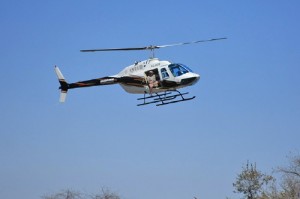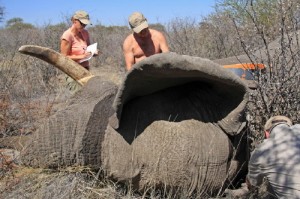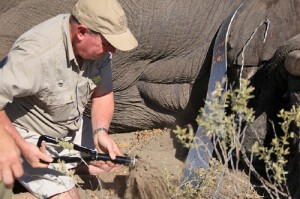Makgadikgadi & Kalahari Desert Elephant Collarings
Deploying collars on elephants is quite an event, perhaps one could say a production. Exciting, but I can certainly add the description “stressful,” as well. (see video, click here) We have been wanting to follow the movements of what we call the “elusive” elephants of the Kalahari, bulls we have seen track s of, and heard reports of, moving in areas where very few elephants go, elephants on the periphery of their ranges, elusive, white ghosts that walk across the barren sands of the extensive and flat Makgadikgadi salt pans. For the last few years, we have flown in hopes to find them… but to have the “collaring team” assembled at the same time when we might spot them is another difficult task of it’s own! We had to try again, and this time was met with success.

Dr. Patterson and Peter Perlstein at work
We began the “exercise” early this past week, when Dr. Mike Chase and I, joined by Dr. Fred Bercovitch of the San Diego Zoo (see EWB partners, click here) moved base from Kasane to Maun to conduct our aerial searches. The first morning, we climbed into the little 4-seater 206 plane, to zig-zag the Kalahari sands, eyes glued to the ground in hopes of the familiar shapes of elephants. We flew many hours without a hint of an elephant in sight. Suddenly, Mike looked over his shoulder to the left and shouted “elephants!” Sure enough a breeding herd comprising of 40+ accompanied by approximately 10 bull elephants were on the move, more than 50km away from any water sources, and what seemed literally in the middle of nowhere! We didn’t expect to see a breeding herd. So, we GPS’d the point and were quite happy. But the following day, we saw their spoor (tracks) but no elephants and our hopes began to wane.
The next day, Dr. Larry Patterson, the wildlife vet who assists us, flew in. Peter Perlstein had his helicopter on hold. ( see EWB’s colleagues, click here) And again, Mike and Fred took to the air in the 206, hoping to spot elephants in the range we wanted to collar. We waited hours for any word, but finally an SMS came in for us to jump into the helicopter and fly to a GPS coordinate where Mike found the bull elephants.

this bull was beautiful and massive
My adrenalin was high as we made our approach, spotting a bachelor herd of 8 elephants in the shade of a tree. At first sight, I always get a lump in my throat and a pit in my stomach until it is finished. We landed to drop the heli doors, so Larry could dart one. All the bulls looked about the same age, so we quickly made our selection and within a fraction of a minute, the dart was in. The helicopter quickly rose up and we circled away from the elephant, keeping a distance as we watched and waited for the drug to take affect. Fifteen minutes later, we landed and were running through thick acacia shrub to get to him. He was a massive bull! just simply beautiful! His tusks were thicker than my legs and a meter long. When up close, I’m always surprised at the enormity of some of the bulls. But there are few words to describe the feeling I have being able to touch his warmth, feel his breathing and smell his hot breathe. It is an indescribable respect that overcomes me and I can’t help feel humble in his presence.
We worked quickly, securing the collar, taking the necessary measurements, and a quick blood and dung sample for analysis. The anti-dote was given and within 2 minutes, he was up, smelled his new adornment and turned to join his compadres. This bull was quick, not even giving me time for a photograph! We took to the air, taking one last look at our new elephant ambassador. We were very happy to have found this bachelor herd and relieved at the days end. (more information on tracking elephants, click here)
he was so quick, the only photo I could get was from the air
But, we were not finished… the next day was even more crucial. Time is money and we were running out of both. We had 3 more collars to deploy and needed to find elephants in completely different areas. Early morn, I joined Mike in the 206, heading east, providing more eyes for better chances of finding some. The early morning light was no help, throwing shadows, making spotting difficult. As we entered over Makgadikgadi National Park, we spotted more bulls, which we believe would be making use of the new artificial water holes that have been put into place. We decided that it was important to collar one of them and chose a younger bull because they tend to have the longest movements or larger home ranges.

We had to dig to slip the collar under his massive head
This time we landed to meet up with the team. Again, I joined the helicopter team, as Mike flew off to keep on his vigilent search. This bull was in another small bachelor herd. Pete was able to land the helicopter quite close to him, which was helpful. His friends were in close proximity, but the sound of the helicopter kept them at a safe distance. He landed with his ear folded to the ground, so Larry had to dig a small tunnel underneath his massive head to slip the collar around him. After building up a good sweat, we managed and were soon in the air, heading back to the ground vehicle to refuel.

soon, he was up and we were on our way
Soon, we received good news from Mike to head much further east. He spotted elephants outside the park. We flew all the way across the Makgadikgadi, a huge treat this time of year because it is in the midst the zebra migration! We could see thousands of zebra working their way across the barren landscape, an unbelievable sight!
Passing the park boundary, we found the plane circling to point out the herd Mike had chosen. This time, Pete had difficulty finding a place to land near the elephant, so we hit the ground running to get to him as soon as we could. The collaring went quickly and smoothly. The only difficulty I had was trying to get measurements, fighting acacia shrub to take them. I managed to get into the helicopter with only a few more scratches though.
the zebra migration across the Makgadikgadi
The fourth elephant was the easiest to collar. We chose a young bull, the youngest thus far, who was with only one other, a larger bull, in the middle of the Makgadikgadi, half way between the other GPS points. He was equally far from water in any direction and thought we should attain some interesting movements from this one. He landed in an open field, so this collaring was quickest and easiest. As we climbed back into the helicopter, watching this young bull join his friend, I could not believe that the day was over and how successful it was. We were definitely exhausted, hot and tired… but, finally I could let out a long, slow breathe and all of a sudden my lump and pit were gone. (to see elephant movement maps, download them by clicking here)
The evening’s conversation revolved around the days events, but mostly about predictions of where these elephants may roam and what questions they may help answer. And I fell asleep dreaming of the elephants roaming in such unusual and barren areas. Why are they out there? What could they possibly be doing right now? We will soon found out.
Relief at the end of the day, as we wake the last elephant
Tags: africa, artificial waterholes, botswana, conservation, elephants, elephants without borders, Makgadikgadi, research








That is one beautiful Bots bull, classic thick tusk’s, hopefully he is a wanderer.